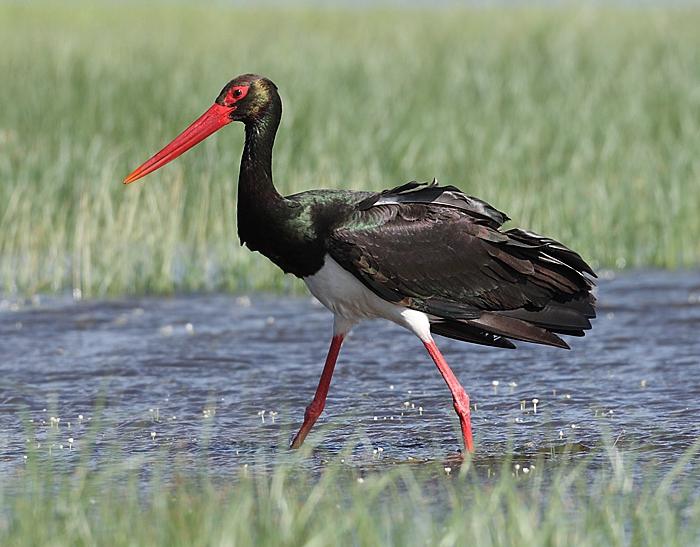Many of us are familiar with white storks, some even saw these huge birds, admired their impeccable nests, built on the roofs of houses or poles. But few people know that in fact there is not one species of these birds. The most rare and interesting from the point of view of study are black storks. Their habitat is wide enough, but the number of birds themselves does not please the conservationists. Over the years, their numbers have remained stably low. Storks nest almost throughout Eurasia, in some regions separate settlements have formed, and in South Africa there is a settled population of this species. At the end of August, birds break away from their places and fly to the southeastern part of China, Africa.

Black storks are slightly inferior in size to their white relatives, but the wingspan usually reaches 2 m. Weight is about 3 kg, legs, beak and skin around the eyes are red, plumage color is black with green and purple tints, only the lower part remains white. It is not so easy to see a bird, because it is not only rare, but also secretive. He prefers to nest near ponds, in old forests, foothills, not to be seen near human settlements.
A pair of black storks create once and for all life. They return from the warm regions at the end of March and are immediately accepted for arranging the nest. There have been cases when in one place for 14 years chicks were hatched. This species of birds does not form colonies, but prefers to settle alone, so one pair occupies a large territory. The female lays up to 7 eggs in the nest. Usually among them there are also unfertilized. A couple incubates eggs in turn for a month.
Black stork chicks have a yellow beak and white or gray fluff. In the early days, they are completely helpless and cannot even eat on their own. They rise to their feet in a month, or even in a half. Nest chicks can leave at the age of just over two months. At the end of summer, gathering as a family, storks fly to warmer climes, although if there is food, they can stay until the first frost. Feathered reach puberty at the age of 3 years.
Black storks feed on frogs, fish, small snakes, lizards, mollusks, large insects. They are able to fly away from the nest for long distances (up to 10 km) in order to hunt in a swamp, wet meadow, shallow water bodies. The presence of offspring imposes additional duties on the birds, the female and the male take turns to go for food for the chicks, feed them 5 times a day. Food burps first, and then it is offered to kids. There is a known case when a stork brought into the nest about 50 frogs weighing more than 0.5 kg.
The number of these beautiful birds decreases every year, although the black stork does not have natural enemies. Photos of birds are admiring and make you wonder what needs to be done so that these beautiful creatures do not disappear from the face of the earth.
Deforestation, reduction of food supply negatively affect the numbers of these birds. This species is listed in the Red Books of Russia, Ukraine, Belarus, Kazakhstan, and agreements on the protection of wintering birds have been concluded with India, Japan, North Korea and Korea.